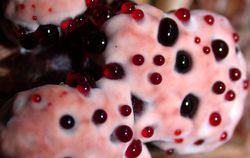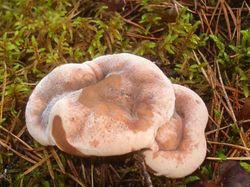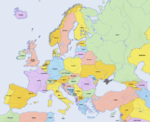Bleeding tooth fungus
| Bleeding tooth fungus |
|---|

|
| Scientific Classification |
|
| Binomial Name |
|
Hydnellum peckii |
| What the fungus looks like when it is older and without substance |
Bleeding tooth, strawberries and cream, and devils tooth, Red juice - would you expect to find these in the woods when you are on a hike? You would if you were looking for a fungus. The Bleeding tooth fungus is a species of fungus known by the scientific name Hydnellum peckii. It is also commonly known as "strawberries and cream" and "devils tooth". This fungus is in parts of the United States and other parts of the world such as Korea, and parts of Europe. This fungus isn't found near the road like other but the woods by tall trees where it has covering from harsh condition, or on a trail. When you think of this fungus you might think of the red substance coming out of it but it doesn't always look like this. When they get older the red substance ( transports spores and also protects the spines) quits being produced, and the mushroom shrivels up and turns brown. Some people think that this fungus is not edible, but it actually is edible - people just don't eat it because it has a bitter taste.
Anatomy
The Bleeding tooth fungus, is a white color with bright red hanging off of the cap. The cap of this fungus can be anywhere from 3 to 10 cm wide. This cap comes in different sizes and shapes, you will see it domed shaped or, flat or sometimes even funnel shaped. The cap is the brightest on the outside of it, the closer you get to the center the darker it gets. It will go from a pink color to a brown. The next part of the fungus is the spines. These spines are very small and help with the spores support. They are on the bottom of cap and the older they get stronger and more dense the spines become. The final major part of the fungus is the stem. This part can be anywhere from 5 to 6cm tall, but that is just the part that you see above ground. There is a portion of the stem below the ground that you do not see.[2]
Another part about the bleeding tooth fungus anatomy is that it does not have the blood like juice coming out of the cap the whole time. The only ones that produce this substances is the younger ones and the middle age ones. The older the fungus gets the less of the substances that comes out. When the fungus is old, it turns a brown pinkish color. It also shrivels up and gets smaller as time goes on.[3] Also as time goes on the bleeding tooth fungus will stop "bleeding". The reason that it bleeds is because of high pressure in the root, so this gooey substance comes out of the top. When the plant gets older, the pressure goes down and eventually the gooey substance will quit coming out and the mushroom will look like a normal mushroom.[4]
Reproduction
The Bleeding tooth fungus can reproduce both sexually and asexually. The common of the two though is asexual reproduction. This particular mushroom produces fruiting bodies called sporocaps that is from the mycelium or from what they call the vegetative parts of the fungus. The purpose of this fungus is to disperse away from the fungus and create more mycelium, which then produces more of the fungi.[5] Also in both asexual and sexual reproduction the produce spores that disperse away from the fungus, by either wind or water. Since the Bleeding tooth fungus can reproduce asexually and sexually that means that it is a perfect fungi. If it only reproduced asexually only then it would be imperfect. [6]. There are several ways that they can reproduce asexually; fragmentation, budding, or spore production, and sexually by mycelia either homothallic or heterothallic. [7]
Ecology
The Bleeding tooth fungus can be found in north America ,specifically in Alaska, North Carolina, Washington ( Puget sound area), and the Oregon coast. It is also found in Europe, they have documented it as being in Italy, Ireland and Scotland. You can also find it in Norway, Netherlands, and Czech Republic, but it is rare to see them in these areas.[8] The person that first found the bleeding tooth fungus was Howard j. Banker. He found the fungus in North Elba, New York. You can find the fungus in the forest, on trails or by or near water sources like a little pond. You might have found or seen them already without knowing it because the didn't have the red substance coming out of them. [9]
Uses of the fungus
Chefs use this fungus as dye for food. People don't really know this because they just think of this as being unedible and that therefore you wouldn't see it in the kitchen. But the truth is you might. chefs use the dye from the fungus to get the colors beige, blue or green.[10]
They use this fungus in the kitchen but also in the medical field. They use this for the atromentin. This is an antibacterial, and is also used to help fight leukemia.[11]
Video
What the Bleeding tooth fungus is and where it is found.
References
- ↑ . [1] Wikimedia. http://species.wikimedia.org/wiki/Hydnellum. 1 June 2012, Author Unknown.
- ↑ [2] British Mycological Society . http://www.earthrangers.com/wildwire/omg-facts/is-the-bleeding-tooth-fungus-really-bleeding/. Author unknown October 26, 2011.
- ↑ O'riley, Pat. [3] British Mycological Society . http://www.first-nature.com/fungi/hydnellum-peckii.php. May 13, 2015.
- ↑ [4] British Mycological Society . http://www.earthrangers.com/wildwire/omg-facts/is-the-bleeding-tooth-fungus-really-bleeding/. Author unknown October 26, 2011.
- ↑ . tooth Wordpress. http://viroola.com/2014/05/18/bleeding-tooth/. May 18, 2014.
- ↑ . [5] Wordpress. https://www.google.com/?gws_rd=ssl#safe=active&q=reproduction+of+fungi/. May 27, 2014, Author Unknown.
- ↑ . [6] Boundless biology. https://www.boundless.com/biology/textbooks/boundless-biology-textbook/fungi-24/characteristics-of-fungi-149/fungi-reproduction-591-11810/. May 26, 2014.
- ↑ . [7] Wikimedia foundation. http://en.wikipedia.org/wiki/Hydnellum_peckii#Ecology. April 15, 2015, Author Unknown.
- ↑ . [8] Wikimedia foundation. https://earthlingnature.wordpress.com/2012/08/10/friday-fellow-bleeding-tooth-fungus/. April 15, 2015, Author Unknown.
- ↑ . tooth Wordpress. http://viroola.com/2014/05/18/bleeding-tooth/. May 18, 2014, Author N/A.
- ↑ Chamarelli , Carlos Augusto. [9] Wordpress. https://earthlingnature.wordpress.com/2012/08/10/friday-fellow-bleeding-tooth-fungus/. August 10, 2012.



